Dental Chair Market Size and Forecast 2025 to 2034
The global dental chair market size reached USD 1.13 billion in 2024, estimated at USD 1.2 billion in 2025 and is anticipated to reach around USD 1.97 billion by 2034, expanding at a CAGR of 5.72% from 2025 to 2034. The rise in surgeries particularly around dental aesthetics is the driving factor of the dental chair market.
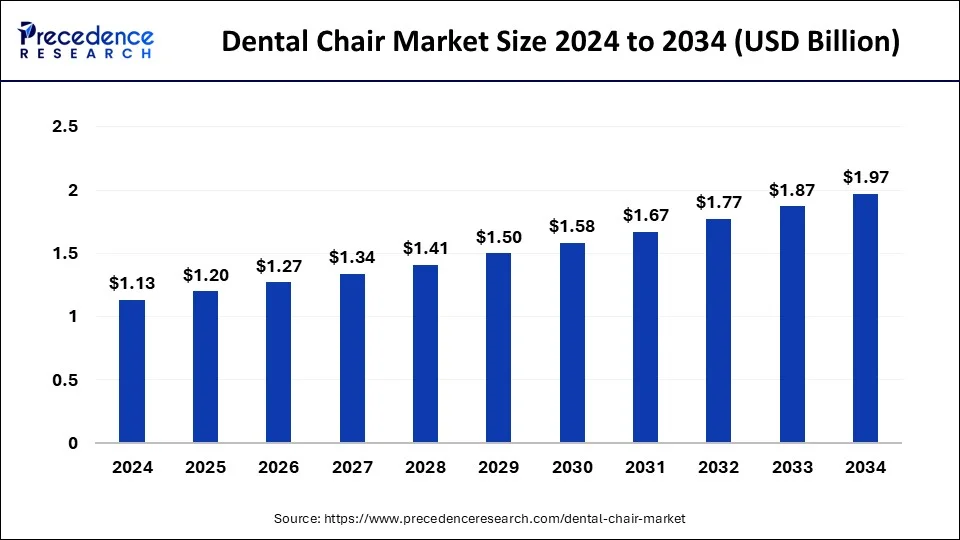
Dental Chair Market Key Takeaways
- The global dental chair market was valued at USD 1.13 billion in 2024.
- It is projected to reach USD 1.97 billion by 2034.
- The dental chair market is expected to grow at a CAGR of 5.72% from 2025 to 2034.
- North America led the market with the largest market share of 39% in 2024.
- Asia Pacific is expected to expand at the fastest CAGR of 6.22% during the forecast period.
- By type, the ceiling-mounted design segment accounted for the largest market share of 40% in 2024.
- By type, the dental chair-mounted design segment is expected to witness the fastest CAGR of 6% over the foreseen period.
- By product, the powered dental chairs segment has held the highest market share of 64% in 2024.
- By application, the examination segment has accounted for more than 30% of the market share in 2024.
U.S. Dental Chair Market Size and Growth 2024 to 2034
The U.S. dental chair market size was estimated at USD 330 million in 2024 and is predicted to be worth around USD 580 million by 2034, at a CAGR of 5.80% from 2025 to 2034.
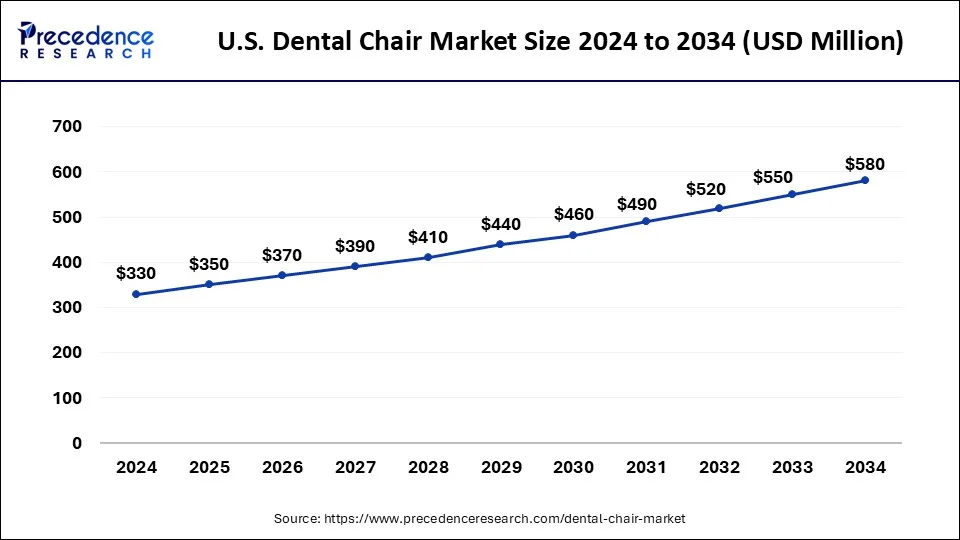
North America stood out as a dominant region within the dental chair market in 2024. The growth is driven by several key factors that collectively contribute to its prominence and leadership in the industry. North America boasts a highly developed healthcare infrastructure, characterized by advanced technological capabilities and a robust network of dental practitioners and clinics. Additionally, the increasing prevalence of dental disorders and the growing emphasis on preventive dental care further drive demand for modern dental chairs in North America.
- An article published in the National Institute of Dental and Craniofacial Research suggests, 2 in every 5 adults in the U.S. are affected by periodontal disease.
North America is home to a significant concentration of leading dental chair manufacturers and suppliers, leveraging their expertise and innovation to cater to the evolving needs of the market. These manufacturers continually introduce new and innovative dental chair models, equipped with advanced features and functionalities to meet the preferences of dental practitioners and patients in the region. Moreover, the infrastructure fosters a conducive environment for the adoption of cutting-edge dental chair technology, as practitioners prioritize offering state-of-the-art equipment to enhance patient care and maintain competitiveness.
With a rising awareness of the importance of oral health and an increasing willingness to invest in dental procedures and treatments, the market for dental chairs in North America continues to expand steadily. Furthermore, favorable reimbursement policies, supportive regulatory frameworks, and a strong focus on patient comfort and experience further bolster the dominance of North America in the dental chair market, positioning it as a key driver of growth and innovation within the industry.
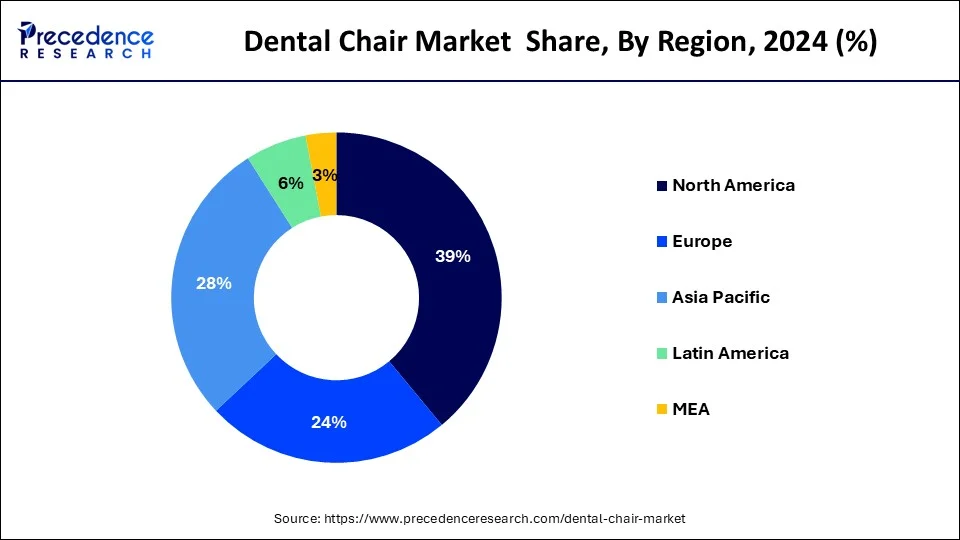
Asia Pacific emerges as a rapidly growing region within the global dental chair market, fuelled by a combination of factors, including economic development, population growth, increasing healthcare expenditure, and expanding dental tourism. With population and rising disposable incomes, countries across the region are witnessing a surge in demand for advanced dental care services, driving the adoption of modern dental chairs. Furthermore, Asia Pacific benefits from the presence of a large pool of skilled dental professionals and a growing number of dental schools and training institutions. As a result, the region is poised to emerge as a key player in the global market, presenting lucrative opportunities for manufacturers and suppliers in the coming years.
Countries such as China, India, Japan, and South Korea are at the forefront of this growth trajectory. China and India, with their massive populations and rapidly expanding middle class, represent vast untapped markets for dental equipment and services. India, likewise, is experiencing significant growth in its dental chair market, supported by factors such as improving healthcare infrastructure, rising prevalence of dental disorders, and increasing healthcare spending. Japan, South Korea, also contribute significantly to the region's growth, driven by technological advancements, government initiatives to promote oral health, and growing medical tourism.
- According to recent data, China's dental market is projected to grow at the highest CAGR between 2021 and 2026, driven by increasing healthcare expenditure and rising awareness of oral health.
Market Overview
The dental chair market encompasses a range of seating solutions integral to dental practices worldwide. These chairs serve as pivotal components in facilitating dental procedures, ensuring patient comfort, and optimizing practitioner efficiency. Characterized by a diversity of offerings, these chairs boast adjustable features, ergonomic designs, and supplementary functionalities such as massage capabilities. Market dynamics are primarily influenced by ongoing technological innovations, rising demand for dental services, and an increasing emphasis on patient-centric care.
Furthermore, the proliferation of dental clinics, coupled with the expansion of dental professionals' practices, continues to fuel market growth. As such, the dental chair market represents a convergence of comfort and cutting-edge technology, aligning with the goal of delivering superior oral healthcare experiences while accommodating the evolving needs of practitioners and patients in dental clinics.
Dental Chair Market Growth Factors
- Technological advancements in dental chair design and features.
- Increasing demand for dental procedures globally.
- Emphasis on patient comfort and experience.
- Expansion of dental clinics and practices.
- Adoption of ergonomic and adjustable seating solutions.
- Rising focus on enhancing practitioner efficiency and workflow.
- Integration of supplementary functionalities such as massage capabilities.
- Growing awareness and investment in oral healthcare.
- Development of innovative materials and manufacturing techniques.
- Expansion into emerging markets and regions.
Market Scope
| Report Coverage | Details |
| Market Size in 2024 | USD 1.13 Billion |
| Market Size in 2025 | USD 1.2 Billion |
| Market Size by 2034 | USD 1.97 Billion |
| Market Growth Rate from 2025 to 2034 | CAGR of 5.72% |
| Largest Market | North America |
| Base Year | 2024 |
| Forecast Period | 2025 to 2034 |
| Segments Covered | Product, Type, Application, and Region |
| Regions Covered | North America, Europe, Asia-Pacific, Latin America, and Middle East & Africa |
Market Dynamics
Driver
Enhanced treatment options
A major driver for the dental chair market is the relentless pursuit of patient-centric care and enhanced treatment experiences. As the dental industry evolves, there's a heightened focus on ensuring patients feel comfortable and at ease during their dental visits. Dental chairs play a pivotal role in achieving this objective by offering various designs, adjustable features, and additional amenities such as massage capabilities.
Furthermore, in an increasingly competitive landscape, dental practitioners strive to differentiate their services by providing superior patient experience. Investing in state-of-the-art dental chairs not only improves patient satisfaction but also enhances the overall perception of the practice's professionalism and commitment to quality care.
Moreover, as consumer expectations continue to evolve, driven by advancements in other sectors, such as hospitality and healthcare, there's a growing demand for dental facilities to provide similar standards of comfort and convenience. This necessitates the adoption of modern dental chairs equipped with advanced technologies and ergonomic designs, thereby driving the growth of the market. Ultimately, the pursuit of patient-centered care remains a cornerstone driver shaping the evolution of the dental chair market.
Restraint
High-cost capital
One significant restraint to the dental chair market is the substantial initial investment required for dental practitioners and clinics to upgrade or invest in new equipment. The cost of acquiring modern, technologically advanced dental chairs can be a hindrance for smaller practices or those operating on tighter budgets. Additionally, the need for ongoing maintenance, repairs, and potential upgrades further adds to the financial burden. In some cases, practitioners may opt to continue using outdated or suboptimal equipment to minimize costs despite the potential negative impact on patient experience and practice efficiency.
Furthermore, regulatory compliance and standards in different regions may necessitate specific features or certifications for dental chairs, adding complexity and cost to the procurement process. These factors collectively contribute to a restraint on market growth by limiting the willingness or ability of dental practices to invest in new dental chair technology.
Opportunity
Remote consultations
An opportunity for the dental chair market lies in the increasing focus on tele-dentistry and remote consultations. With advancements in technology and the growing acceptance of virtual healthcare services, by incorporating features such as remote-controlled adjustments, high-definition cameras, and audio-visual communication tools into dental chairs, practitioners can effectively conduct virtual consultations with patients in real time. This integration enhances accessibility to dental care, particularly for individuals in remote or underserved areas. It is also helpful for those seeking second opinions from specialist practitioners located elsewhere.
Moreover, tele-dentistry presents a means for dental practices to expand their reach and attract a broader patient base beyond their immediate geographical status. By offering virtual consultations, practitioners can establish relationships with patients, provide initial assessments, and recommend treatment plans before scheduling in-person appointments, thereby streamlining the patient journey and improving overall efficiency.
Additionally, the integration of dental chairs with tele-dentistry platforms opens up opportunities for collaboration and knowledge sharing among dental professionals, fostering continuous learning and professional development within the industry. Therefore, embracing tele-dentistry represents a promising avenue for innovation and growth within the dental chair market. In turn, catering to evolving patient needs and expanding market value globally.
Type Insights
The ceiling-mounted design segment accounted for the largest market share in 2024. One of the major driving factors of the ceiling-mounted design segment is the flexibility it offers. It is unmatchable with other dental chairs, including ease of moving and handling the chair as per requirement, so the orientation of the layout could be changed using a flexible unit for storage.
The ceiling-mounted design chairs are manufactured to provide storage units for mobiles at the head of the chair and accessories such as lamps and trays to proceed with dental operations. Thus, they provide higher mobility with better control or grip over the dental chair, which is the most significant and crucial part of dental operations as they include highly delicate performance on teeth and their alignment. The crucial part is that most of the nerves from the roots of teeth are directly connected to the brain part, which is connected to the sensory and motor area in the frontal lobe of the human brain. Therefore, it is essential to take utmost care while performing any kind of teeth surgery.
The dental chair-mounted design segment is expected to witness the fastest growth over the foreseen period. The growth of this segment is attributed to its simple design and low maintenance. These chairs have special features such as a mounted touchpad and wireless control for better control and convenience for treatments.
Product Insights
The powered dental chairs derived the highest market share in 2024. Surprisingly, powered dental chairs are the only segment by type that is expected to grow at the fastest rate in the foreseen period. Such dominance over the market, including the higher rate of growth, is comprised of the desire for skilled dentists to provide the best possible and highly reliable plus safe service to the patients along with easy accessibility and flawless operations, which, in turn, increases their frequency of patients.
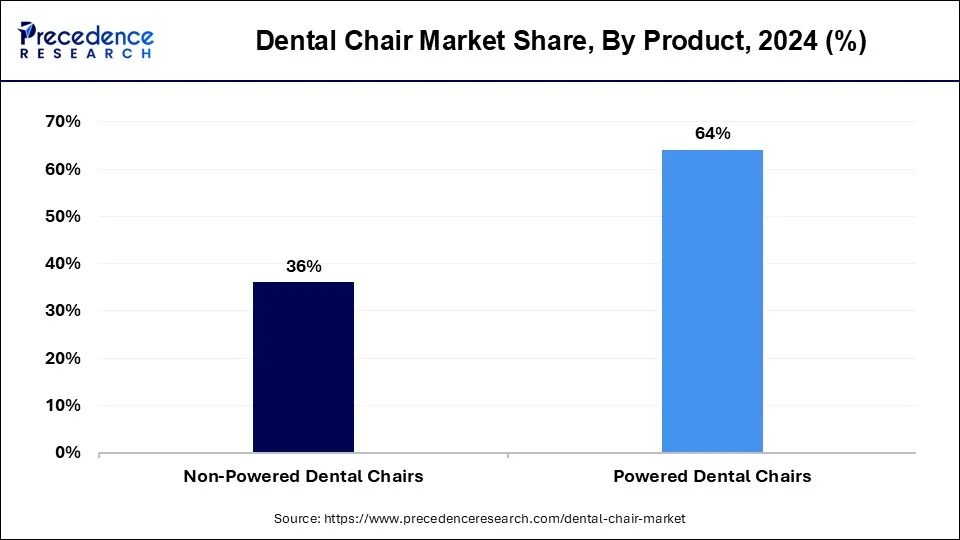
A powered dental chair is a sophisticated piece of equipment designed to enhance patient comfort and practitioner efficiency during dental procedures. Equipped with motorized mechanisms, these chairs offer adjustable seating positions. With the touch of a button, the chair can be reclined, raised, lowered, or tilted to optimize accessibility and ergonomics for both the patient and the dentist. Powered dental chairs often feature additional amenities such as integrated lighting, foot controls, and memory presets, contributing to a seamless and comfortable dental experience for patients while facilitating smoother workflow for dental professionals.
Application Insights
The examination segment held a significant share of the dental chair market in 2024. A dental visit examination by professionals is a comprehensive assessment of a patient's oral health conducted by trained dental practitioners. It typically begins with a thorough review of the patient's medical history and any concerns they may have regarding their oral health. During the examination, the dentist examines the teeth, gums, and surrounding oral tissues for signs of decay, disease, or abnormalities. They may also perform diagnostic tests such as X-rays to assess the underlying structures of the teeth and jaw.
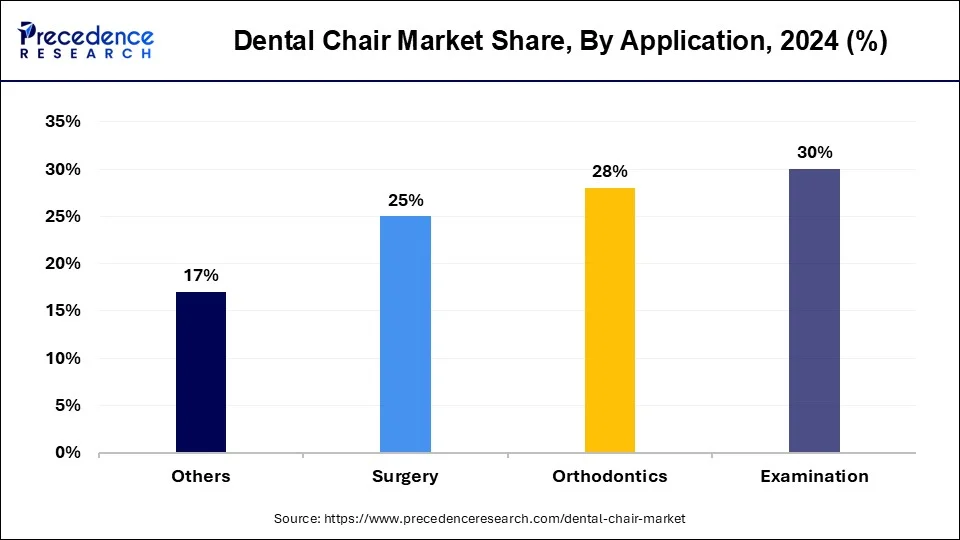
Examination may also include an assessment of the patient's bite practices, jaw alignment, and oral hygiene practices. Dental professionals use specialized instruments and techniques to detect issues such as cavities, gum disease, oral cancer, and temporomandibular joint disorders. Based on their findings, the dentist develops a personalized treatment plan tailored to address any identified issues and improve the patient's oral health. They may also provide guidance on preventive care practices, such as brushing, flossing, and regular dental check-ups, to maintain optimal oral hygiene.
- According to the Center for Disease Control and Prevention (CDC), 64.1% of adults above 18 years of age had a dental exam or cleaning in 2022.
The surgery segment is considered a significantly growing segment of the market. Rising dental surgery refers to the increasing demand for surgical procedures performed by dental professionals to address a variety of oral health issues. This trend is driven by several factors, including advancements in dental technology, changes in patient demographics, and evolving treatment preferences. Furthermore, the growing emphasis on preventive and cosmetic dentistry has led to a rise in elective dental surgeries aimed at improving the appearance and alignment of teeth, such as orthodontic surgeries and teeth whitening procedures.
One contributing factor to the rise in dental surgery is the aging population, as older individuals are more prone to dental problems such as tooth decay, gum disease, and tooth loss. As a result, there is a growing need for surgical interventions such as dental implants, periodontal surgeries, and oral surgeries to restore oral function and aesthetics in this demographic. Additionally, advancements in dental technology have expanded the scope of surgical procedures available to patients. Techniques such as guided implant surgery and minimally invasive surgeries have made dental treatments more precise and comfortable for patients, driving increased demand for surgical interventions.
Dental Chair Market Companies
- Austin Dental Equipment Company (A-Dec, inc.)
- Midmark
- Craftmaster Contour Equipment, Inc
- XO CARE A/S
- Sirona
- Henry Schein, Inc.
- Danaher Corporation
- PLANMECA OY
- Patterson Dental Supply, Inc
- Straumann
Recent Developments
- In 2023, Dentist, a dental equipment manufacturing company, presented an innovative dental chair model, the LUVIS Chair, at the Seoul International Exhibition (SIDEX).
- In March 2023, according to the fact sheets published by the World Health Organization (WHO), oral diseases affect approximately 3.5 billion people, whereas severe periodontal diseases affect 19% of the population globally.
Segments Covered in the Report
By Product
- Powered Dental Chairs
- Non-Powered Dental Chairs
By Type
- Ceiling-mounted design
- Mobile-independent design
- Dental chair-mounted design
By Application
- Examination
- Surgery
- Orthodontics
- Others
By Geography
- North America
- Europe
- Asia Pacific
- Latin America
- Middle East and Africa
For inquiries regarding discounts, bulk purchases, or customization requests, please contact us at sales@precedenceresearch.com
Frequently Asked Questions
Ask For Sample
No cookie-cutter, only authentic analysis – take the 1st step to become a Precedence Research client
 sales@precedenceresearch.com
sales@precedenceresearch.com
 +1 804-441-9344
+1 804-441-9344